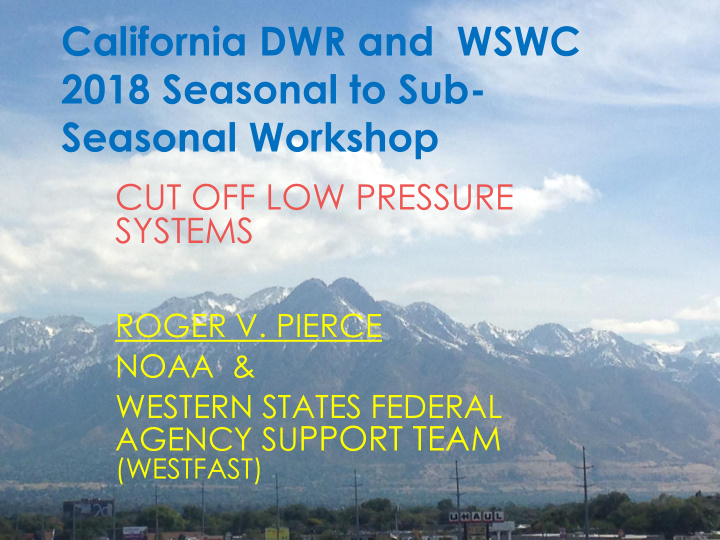



California DWR and WSWC 2018 Seasonal to Sub- Seasonal Workshop CUT OFF LOW PRESSURE SYSTEMS ROGER V. PIERCE NOAA & WESTERN STATES FEDERAL AGENCY SU PPORT TEAM (WESTFAST)
WestFAST Environmental Protection Agency National Oceanic Atmospheric Adm. Bureau of Reclamation Bureau of Land Management U.S. Geological Survey U.S. Fish and Wildlife Service U.S. Forest Service Natural Resources Conservation Service U.S. Army Corps of Engineers U.S. Department of Defense U.S. Department of Energy National Aeronautics & Space Adm.
NOAA National Centers for Environmental Prediction Aviation Weather Center (AWC) Climate Prediction Center (CPC) Environmental Modeling Center (EMC) Weather Prediction Center (WPC) NCEP Central Operations (NCO) National Hurricane Center (NHC) Ocean Prediction Center (OPC) Storm Prediction Center (SPC) Space Weather Prediction Center (SWPC)
NWS Product Focus
Climate Prediction Center ORIGIN OF THE FORECAST PRODUCTS… WITH HELP FROM: Weather Forecast Offices • NOAA Satellite Information • Service NOAA Ocean Service • National Data Buoy Center • NOAA Research • Scripps – and many other • research and data collection organizations
Cut Off Low Pressure Systems (Blocking Pattern ) Omega Block Rex Block Cut off /Blocking High Pressure Cut Off Low Pressure
Simplified Global Winds
More Realistic Flow
Vertical Structure of the Atmo – sphere Trop – 35,000 ft Strato – 100,000 ft StraPause – 160,000 ft
90,000 ft 35,000 ft 18,000 ft 5000 ft
Westerlies - Wind Pattern Flows West to East
Westerlies - Wind Pattern Flows West to East https://earth.nullschool.net/#current/wind/surfac e/level/orthographic=-133.12,9.81,263
What causes it to cut off? Low starts off as a small wave in the westerly winds Winds increase on the west and south side as this “wave” decreases in pressure If the winds increase enough, it produces a breaking wave pattern such that as winds increase further and round the bottom of the low pressure system It breaks away from the westerly flow and nearby induced high pressure forces winds around the low pressure, further cutting it off from the main stream flow
Omega Block
Rex Block
Cut Off / Blocking High
Cut Off Low Cut to examples from comet
0 hours later (5/10/18)
12 hours later (5/11/18)
24 hours later (5/11/18)
48 hours (May 12, 2018)
72 hours (May 13, 2018)
96 Hours (May 14, 2018)
120 Hours (May 15, 2018 )
144 Hours (May 16, 2018 )
168 Hours (May 17, 2018)
192 Hours (May 18, 2018)
216 Hours (May 19, 2018)
240 Hours (May 20, 2018)
Integrated Transport - Plainview
How did the model do? May 16, 3028
Observed 144 Hours (May 16, 2018)
Credits – great graphics Ultimate Weather Eduction Website: http://www.theweatherprediction.com UCAR COMET: https://www.meted.ucar.edu Twister Data http://www.twisterdata.com NCEP GFS: http://www.ncep.noaa.gov/
DATA
DATA
Weather Climate Linkages § ENSO Cycle ( El Niño/La Nina) § Madden/Julian Oscillation (MJO) § Teleconnections § Blocking
ENSO
Madden - Julian
Climate.gov drawing by Fiona Martin.
Blocking
Future A lot of work to go Research - That isn’t being funded appropriately at the Federal level - rp
Sea Surface Temperature
Products www.cpc.noaa.gov 6-10 Day Outlook Subset -running precipitation accumulation (CFS) 8-10 Day Outlook Subset – running precipitation accumulation (CFS) 30 Day Outlook, updated every 15 days 90 Day Outlook Running 90 day Outlooks to a year
Teleconnections §AO (Arctic Oscillation) §NAO (North Atlantic Oscillation) §PNA (Pacific-North American Pattern) §AAO (Antarctic Oscillation) §Archive of Daily Indices §Monthly Teleconnection Indices
AO and AAO
North Atlantic Oscillation / Pacific - North American pattern (NAO/PNA)
Products www.cpc.noaa.gov 6-10 Day Outlook Subset -running precipitation accumulation (CFS) 8-10 Day Outlook Subset – running precipitation accumulation (CFS) 30 Day Outlook, updated every 15 days 90 Day Outlook Running 90 day Outlooks to a year
CFS Week 3 and 4
CPC week 3 and 4 forecasts beyond Day 6-14 outlooks
North America Multi- Model prediction Drier Tropics due to cooler waters
Day 3-7 Hazards Outlook
Product Changes Experimental Week 3 and 4 Temperature – Operational in 2017 Experimental Week 3 and 4 Precipitation – little skill and continues in development Hazard Products – Probabilistic Sea Ice Extent Product in Development
People and Money CPC staff 39 – lowest in it’s existence (48) Directly tied to S2S 4 to 8 people ($500k) Collaborative forecast process ($500k) Product development ($200k) Total CPC 9 Million CFS – Environmental Modeling Center leveraging – Not a clean cut value. Computing – huge – separate funding NOAA Research – Climate Program Office, PSD, ARL, CSD, GSD, and NESDIS.
Integrated Water Vapor Transport
CFS 20 Member Ensemble 500 mb
Am I Out of Time?
Future A lot of work to go Research - That isn’t being funded appropriately -rp
Recommend
More recommend